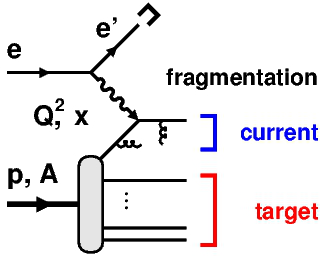Measurements of target fragmentation in DIS have great potential for studying nucleon structure and nonperturbative QCD but have been little explored so far. Target fragmentation gives access to the nucleon’s multiparton structure and correlations, which are the next frontier after the single-parton densities. The theory of target fragmentation in DIS is well developed, employs leading-twist QCD factorization and distributions, and is in some respects simpler than that of current fragmentation (TMD factorization). The use of spin/flavor quantum numbers in target fragmentation offers new ways to study nucleon spin structure, intrinsic strangeness, and quark-antiquark correlations related to dynamical mass generation in QCD.
Target fragmentation measurements represent a new opportunity for the EIC and could significantly extend the reach of the 3D nucleon structure program. This initiative needs a concise formulation of the physics case, development of simulation tools, and assessment of the requirements for forward/far-forward detectors. It is expected that target fragmentation measurements would be feasible with the baseline EIC detector specifications assumed in the on-going Yellow Report studies. The concepts and tools can also be tested by analyzing the archived HERA data on forward proton/neutron production and x_F distributions, which are now available in a database.
Target fragmentation is also important for understanding/modeling nuclear breakup in DIS on nuclei in measurements of spectator tagging and diffractive processes. Final-state interactions of the spectator nucleons with the slow DIS hadrons in the nucleon fragmentation region influence the nuclear breakup pattern. The lack of data and theoretical models on nucleon fragmentation has been a major impediment in this field. Conversely, nuclear breakup measurements can be used to explore the space-time picture of hadron formation and quantify the relevant time/distance scales. Such studies need joint discussions and exchanges between researchers working on DIS fragmentation and low-energy nuclear breakup (cascade models).
Objectives
- Review physics of target fragmentation at fixed-target and collider energies
- Develop plan for target fragmentation measurements at EIC
- Initiate analysis of archived HERA data for pre-EIC target fragmentation studies
- Stimulate theoretical research in nucleon fragmentation and nuclear final-state interactions
Topics
- QCD description of target fragmentation in DIS
- Dynamical models of nucleon fragmentation and fracture functions
- HERA forward proton/neutron data and future analyses
- Spin/flavor and multiparton correlations in target fragmentation
- Target fragmentation in fixed-target experiments JLab12/COMPASS
- Nucleon fragmentation and nuclear breakup in DIS
- Cascade models of nuclear final-state interactions
- Target fragmentation with EIC forward detectors and Yellow Reports
Format: On-line only. Sessions scheduled for 09:30-15:30 EDT to allow for simultaneous participation from European and US timezones. Extensive time reserved for topical discussions.
Organizers: J.-H. Lee (Brookhaven National Lab), Marta Ruspa (U. Piemonte Orientale Novara/INFN Torino), Anna Stasto (Penn State U.), Mark Strikman (Penn State U.), Christian Weiss (Jefferson Lab, Contact: weiss@jlab.org)

